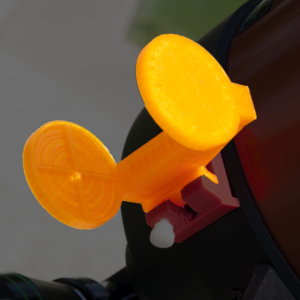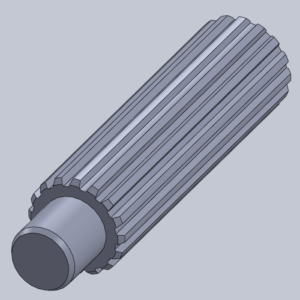Welcome to MythBusters!
Recently the question was raised as to whether or not it was safe to run your electronic telescope mount and a dew heater off of the same battery. As usual, proponents lined up on both sides of the topic and fired salvos across at each other. While many claimed that they’ve run multiple devices of the same battery for years without problems, others warned that in the long run, damage will result due to surges caused by the switching of the power to the different equipment, and many just say “Why risk it with your expensive electronics.” The technical arguments also went back and forth, with some arguing that a battery is a battery and can’t put out any more than its maximum voltage, while others claimed that your mount could get hit by a surge of 40 volts or more if you weren’t careful.
I should note that I started out on the side of “I’ve done it for years without a problem” and have used AC power supplies instead of batteries (considered sacrilege by some who fear surges there more than anything). However, considering the possible configurations people were using, I got to applying my physics and engineering background (I actually work for a company whose principal products are all for testing for electromagnetic interference) and realized that there’s the very real potential for hazardous spikes from your 12V supplies, and not all of them may be due to separate pieces of equipment.
I’m not going to delve too deeply into the technical jargon here, but feel I should summarize for those who are interested. You can easily do an internet search to find out more on the topics here, so I’ll leave that for the interested reader. At any rate, the culprit that we need to talk about here is called inductance. There are actually three passive components to any electrical circuit, resistance, capacitance, and inductance. Resistance results in a loss of electrical energy in the form of heat, while inductance and capacitance store energy temporarily. The important thing to note here is that any conductor (wire, etc.) has some amount of inductance (the ability to store energy magnetically). Coils of wire (e.g. an electromagnet) have more inductance, but it’s always there.
The other two terms that we need to talk about are voltage and current. Most people are aware of voltage at least conceptually, so when we talk about a 12V car battery, you have some idea what we’re talking about. Voltage is the ability to push charge (e.g. electrons) around. The more voltage you apply, the harder/faster you can push the charge. Current, on the other hand is just the rate at which the charge is flowing. Higher current means the either more charge moving at the same rate, or faster moving charges. Think of it as water flowing down a hose and the voltage as the pressure on the hose.
Now, just like that water in the hose, once you get it moving, it doesn’t want to stop. Just like kinking the hose will cause a surge in pressure, so does suddenly breaking a circuit that has current flowing in it. The result is a surge in voltage. That surge can even be large enough to break down the dielectric of air, which is why you see sparks sometimes when you switch off a light switch or yank a plug from the wall. The equation for the voltage produced (this is the only one, I promise!) is given by:
V = L di/dt,
where L is the inductance (the tendency of the circuit to have stored magnetic energy due to the current flowing through it) and di/dt is the rate of change of the current in the circuit. So, if you have a large current that you suddenly try to turn off, either due to the switching of something like a dew heater or just unplugging a large load, then the rate of change of the current from several amps to zero can be huge. Thus, even for very small inductances found in straight wires, the voltage spike can be considerable. The other important thing to note here is that this has nothing to do with the voltage of the power supply! Nowhere in the above equation does the supply voltage of the battery come into play. Even the current is only peripherally involved in that higher current generally means a higher rate of change when you try to go from full current to zero instantly.
But that’s all theory. Some people won’t believe theory, especially when they don’t fully understand it. Arthur C. Clarke, one of the science and Sci-Fi greats (2001 A Space Oddysey, but seriously, if you’re reading this and don’t know that, then you may be in the wrong place!) used to say that “Any sufficiently advanced technology is indistinguishable from magic” (Clarke’s third law). So for those who firmly believe that the power supply to their scope can never exceed the 12V provided by the battery, this will probably seem like magic. However, as I’m fond of saying, “In God we trust; all others bring data.” Thus, to attempt to prove once and for all, I did a little myth busting of my own. And while I’m sure I’ll have plenty saying I did it wrong, the results are hard to argue with.
So here’s the test setup. A three-way cigarette lighter splitter is plugged into the truck accessory port with the engine off (12V battery power only). An oscilloscope is connected to the power cable that would normally run my Meade mount. A cigarette lighter is used to simulate the load of a dew heater, and the oscilloscope is configured to trigger on any voltage rising above about 16 volts.

Here’s what happens when the lighter reaches temperature and pops out, breaking the circuit to the “dew heater”. There are actually a number of spikes due to the lighter not switching off all at once, but the final disconnect results in a spike of about 37 volts! If we had a really clean quick break, the spike could have been considerably higher. Note too how the voltage going to the “mount” is not at the battery voltage to start with due to the load of the heater and the resistive losses in the cable that it’s pulling the current through. However, if I were to have gone to the battery itself, little or no voltage drop would have been visible due to the load, and after the current shuts off and things settle down at the splitter port, the voltage measured is back to its normal level.
Here’s a zoomed in view of that biggest pulse. Note that if it wasn’t for a second harmonic (don’t worry about it — my tech speak leaking through) riding on top of the first oscillation, this would have easily exceeded the 40V or more pulse that some were warning of.
It should be noted (in case someone bothers to check) that the splitter in the picture came with a “battery protection circuit” that didn’t work and wouldn’t have done much for the battery if it did. That was removed and the outputs cabled directly, so there’s nothing in line with this other than the single zip cord you see going to the lighter outlet. Note too that I also ran this same test monitoring directly off the truck auxiliary port with the lighter in the normal lighter port and got pretty much the same result. The only difference was that there wasn’t as much of an initial voltage dip due to the current going to the heater.
So, is it safe to run multiple pieces of equipment together? That all depends on how much protection the manufacturers added to their hardware. You can be pretty sure that the brute force components like dew heaters, etc. don’t do much to limit the surge, and may not be able to at all. And despite the cost of my high end mounts, I’m not sure I trust that the manufactures did much to protect them either. Certainly older electronics are less likely to have the electromagnetic compatibility testing and protection that may have been added to newer products as industry requirements changed. And while the nay-sayers may not have had a problem yet, the insidious thing about voltage surges/spikes is that the effects are cumulative. A circuit may not fail under the first spike, but after enough of them, it will. And as a final note, remember that this can happen easily with ANY sudden discontinuity in a high current load. I’d suspect that accidentally unplugging your scope while it’s slewing is probably as bad or worse than your dew heater flipping on and off. There’s a lot of inductance in those motors and suddenly turning off the power can cause some hefty back EMF (look it up).
At any rate, it’s up to you who you want to believe. I know what the data shows me, and I’m definitely re-thinking the way I deal with my scope power supplies. I hope this has helped someone else make an informed decision.
Michael

















3 Responses to Should you run multiple devices off of the same power supply?